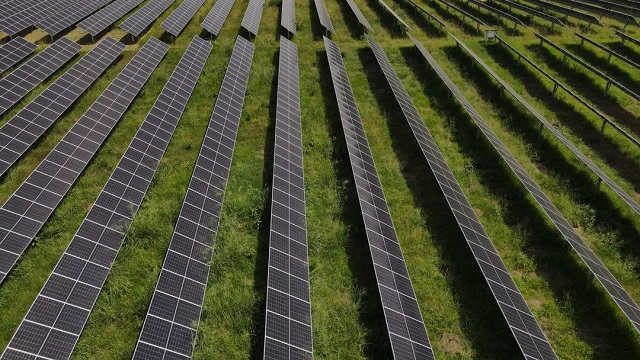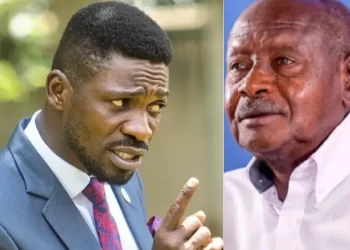By THE INDEPENDENT UG
Uganda Development Bank-funded solar plant will add 20MW to national grid
Kampala, Uganda | IAN KATUSIIME | Tucked away in the hills of Mubende in Kyakasa village lies a solar power plant that is part of efforts aimed at powering Uganda’s energy transition. The Xsabo Nkonge power station with its gleaming 380,000 solar panels seated on a 120 acre piece of land will add 20MW of power to the national grid once completed.
The power plant is located in Kasambya County in Mubende district in a remote area teeming with large farms, cattle keepers, and where residents mostly live in mud and wattle houses.
As Uganda Development Bank (UDB) released its annual performance reported, it organised a sightseeing trip on February 28 for officials from the Ministry of Energy, Electricity Regulatory Authority (ERA) and journalists for the Nkonge solar project which it is funding. UDB funded the project at a cost of $21m and the construction of the facility started in 2021.
The Xsabo Nkonge solar line is a photovoltaic project that will provide solar electricity to the national grid and it is an initiative by UDB in supporting Uganda’s sustainable development. The Nkonge power plant is located near the 20 MW Kabulasoke plant in Gomba district which President Yoweri Museveni commissioned in 2019.
Both plants are owned and operated by The Xsabo Group, a business conglomerate in several countries with interests in energy, fast moving consumer goods, financial services and healthcare.
David Alobo, Founder and CEO of The Xsabo Group, said the Nkonge power plant is expected to be fully operational by March 31. “What we are waiting for is the solar power plant’s starter which is on the way by ship. We expect to begin full power generation operations after the launch of the plant by 31st March,” he said at the site of the project.
Alobo added that the Nkonge project is the most modern solar power plant in Sub-Saharan Africa with 20MW thanks to some of its features. “I wholeheartedly thank Uganda Development Bank for providing the loan facility that has enabled successful construction of this solar power plant. It will be ready for commissioning before March 31st.”
The solar panels at the Nkonge plant are laid out in strips, each 92m long, and are designed to follow the movements of the sun according to the manager of site, Eng. Samuel Walusimbi. The manager said that the plant has created jobs for area residents through the technical support they provide. Walusimbi added that the plant is fenced off to prevent animals from wandering in among safety measures.
80MW solar portfolio
The Nkonge solar plant will push Uganda’s grid-connected solar portfolio to 80.6 MW joining other five plants already connected with a combined capacity of 60.6 MW.
Alobo said the solar projects operated by Xsabo are securing a better future for current and future generations by powering development. “This makes The Xsabo Group part of a growth agenda to build resilience, catalyse sustainable growth and promote net-zero economic transition in Uganda and across Africa as the world economy moves towards a low carbon future,” he added.
ERA issued a license to Xsabo Nkonge solar line II to construct and operate the 20 MW solar plant, in Mubende in 2020, Sarah Kanaabi, the chairperson of the electricity regulator said. She was representing the Minister of Energy Ruth Nankabirwa at the function.
This was after thorough scrutiny of the relevant technical, financial, environmental, and social evaluations and considerations. The validity period for the license is 21 years and three (3) months of which 1 year and three months are for construction.
“Once construction is completed, power generated from the plant will be sold to the government through the Uganda Electricity Transmission Company Limited (UETCL) at US Cents 7.1 Kilowatt Hour, which is the lowest tariff among the existing solar plants,” Kanaabi said.
She revealed that the new solar line will interconnect along the 132 KV Kabulasoke-Nkonge Transmission line and will largely serve electricity consumers connected to the Nkonge and Kabulasoke substations.
“This is a key milestone in Uganda’s energy profile and it speaks directly to the Local Content and BUBU Policies of the Government of Uganda,” Kanaabi said.
Last year, the Ministry of Energy and Mineral Development launched the National Energy Policy 2023. The objective of the new policy, in part, is to ensure a sustainable, adequate, affordable, and reliable supply of energy, setting an ambitious plan of increasing the country’s installed generation capacity from the current 1,842 MW to 24,000 MW by 2040. This is to meet the government’s per capita [annual] consumption goal of 3 668 kWh.
Shs50 billion Climate fund
As part of UDB efforts at supporting a green economy, the bank has created a Climate Finance Facility. This is a Special Purpose Vehicle with a unique and specific focus on financing, unlocking, and catalyzing private sector investment in local green sectors that drive green impact and financial inclusion.
The Bank committed Shs50 billion towards the capitalisation of this facility. The beneficiaries are also exposed to the Bank’s Green Advisory as well as the Project Preparation Support to make them bankable but more importantly grow them to become viable green businesses.
Uganda Development Bank’s (UDB) gross loan disbursements in the year 2023 grew by 21 percent while its total assets rose by 8 percent in a year marked with a roll out of new initiatives towards supporting the private sector. During the year 2023, the Bank approved funding amounting to Shs691 billion to support 201 projects across the country.
The results indicated an 8% growth in assets from UGX1.52 trillion in 2022 to UGX1.64 trillion last year.
This growth was driven by the increase in gross loans to customers, which inched up by 24 percent to close the period at UGX1.6 trillion.
“During 2023, we delivered a strong set of results, consistent with the performance trend over the last couple of years, and in line with our role as the country’s Development Finance Institution,” said Patricia Ojangole, the UDB Managing Director.
“The Bank continues to make progress on its strategy implementation, fulfilling our primary mandate of generating tangible development outcomes that propel the country’s socio-economic progress. We remain resolute on carefully balancing these efforts with the need to be a financially sustainable institution,” Ojangole added.







Discussion about this post